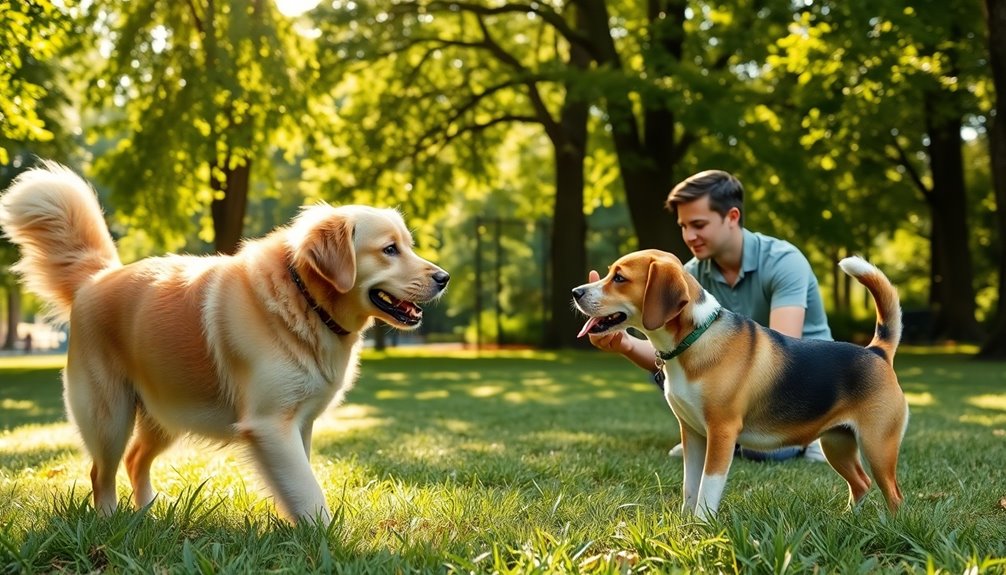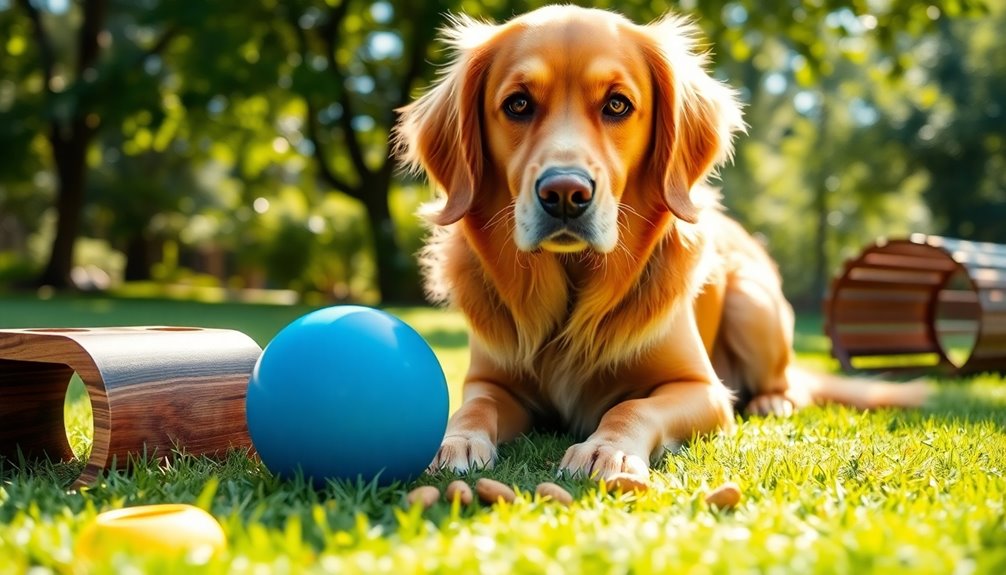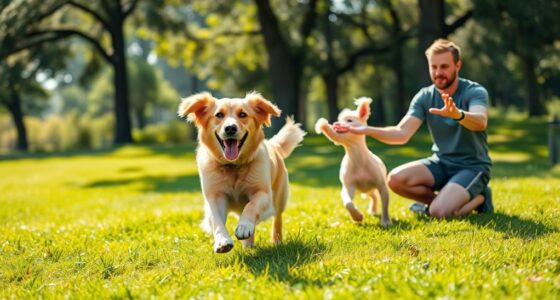To solve aggression in dogs, you need to understand its root causes, like fear or possessiveness. Start by recognizing signs like growling or rigid posture, which signal discomfort. Effective training using positive reinforcement can reshape aggressive behaviors. Gradual exposure to triggers can help desensitize your dog and reduce aggression over time. Don't overlook the importance of consulting a veterinarian to rule out any underlying medical issues. With consistent training and professional support, you can create a safer environment for both you and your dog. There's a lot more to uncover about ensuring long-term success and harmony in managing aggression.
Key Takeaways
- Identify and understand the type of aggression—fear-based, possessive, or territorial—to tailor your approach effectively.
- Conduct a thorough medical evaluation to rule out underlying health issues that may contribute to aggressive behavior.
- Implement positive reinforcement techniques and gradual desensitization to modify aggressive responses and encourage calm behavior.
- Create a safe environment with management strategies like leashes, gates, or crates to prevent aggressive incidents.
- Maintain ongoing communication with trainers and veterinarians for continuous support and adaptation of behavior modification strategies.
Understanding Dog Aggression
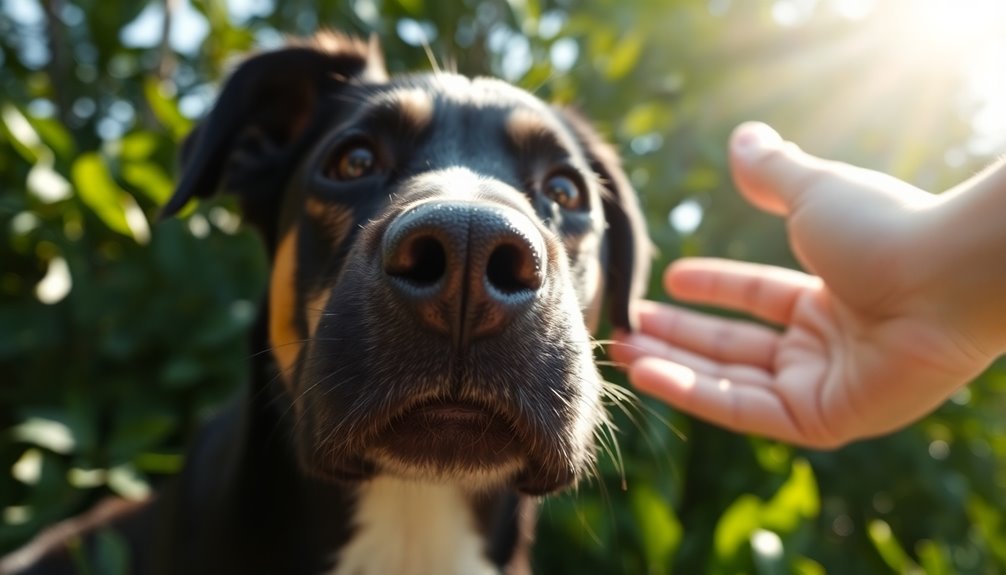
Understanding dog aggression is crucial for any pet owner who wants a harmonious relationship with their canine companion. Dog aggression can manifest in many forms, from fear-based aggression to possessive aggression, each with unique triggers and causes.
Fear-based aggression often arises from anxiety or past trauma, while possessive aggression generally stems from resource guarding instincts.
To effectively manage dog aggression, you need to identify aggression triggers, like perceived threats or changes in routine. Environmental factors, such as new pets or disruptions in daily life, can exacerbate aggressive tendencies. By recognizing these triggers, you can take proactive steps toward behavior modification.
Training techniques play a significant role in addressing aggression. Consistent training, along with positive reinforcement, can help reshape your dog's behavior.
If you're struggling to manage your dog's aggressive tendencies, consider consulting a professional dog trainer. They can offer tailored strategies and insights to help you better understand dog aggression and create a safer environment for both you and your pet.
Warning Signs of Aggression

Recognizing the warning signs of aggression in dogs is vital for preventing dangerous situations. Pay close attention to growling, snarling, or snapping, as these indicate your dog's discomfort or perception of threat. Early signs often manifest through visible anxiety, such as showing the whites of their eyes or excessive lip licking. These behaviors can precede aggressive outbursts, so don't ignore them.
Body language is important in identifying potential aggression. A rigid body posture, a tail that wags quickly but with a tense demeanor, or a cowering stance with a tucked tail can signal discomfort and anxiety.
Fear-induced behaviors, like urination or cowering, often indicate an aggressive response rooted in anxiety or fear of specific triggers.
Identifying these triggers—whether unfamiliar people, other dogs, or certain environments—can help you recognize and address aggression effectively.
Medical Evaluation Importance
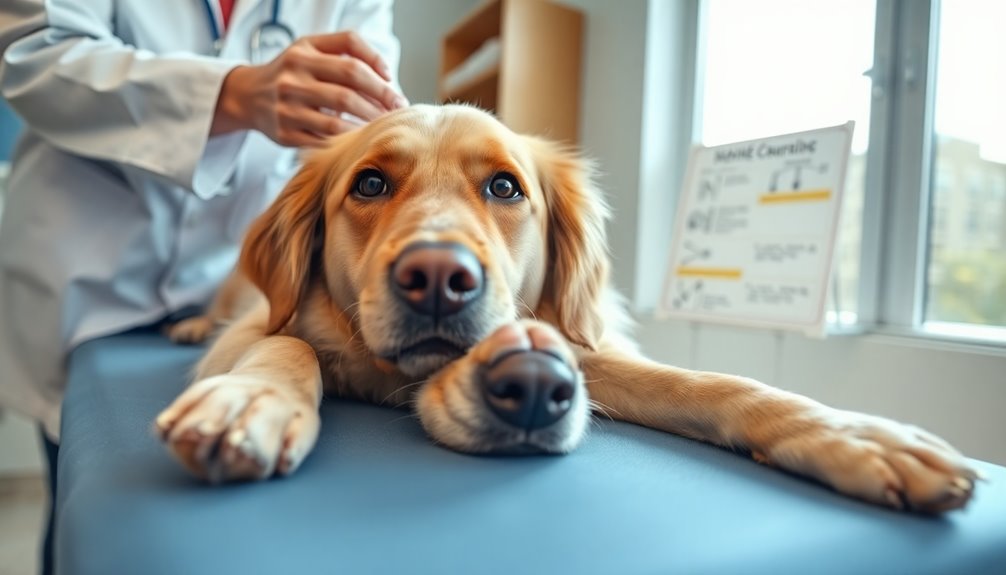
When your dog suddenly shows aggression, it's vital to contemplate potential underlying health issues.
You should consult a veterinarian to rule out conditions that may be causing pain or discomfort, as these can lead to defensive behaviors.
A thorough medical evaluation can provide insights that are essential for effective behavior modification.
Identifying Underlying Health Issues
Sudden changes in a dog's behavior, like aggression, can often point to underlying health issues that need immediate attention.
It's vital to consult your veterinarian to rule out any medical triggers before diving into behavior modification strategies. A detailed veterinary evaluation can uncover conditions such as hypothyroidism, injuries, or neurological disorders that may cause aggression issues.
Consider these points when evaluating your dog's situation:
- Pain-induced aggression can stem from untreated injuries or illnesses.
- Regular health check-ups help identify potential medical triggers that affect behavior.
- A collaborative approach with both your veterinarian and a veterinary behaviorist can lead to effective management of aggressive behaviors.
Addressing these underlying medical concerns is essential. Tick removal from pets can also help alleviate discomfort that may contribute to aggressive tendencies.
Once you identify and treat the health issues, you may notice significant improvements in your dog's behavior.
By understanding the link between health and aggression, you reinforce the importance of an all-encompassing evaluation.
Don't wait; addressing the root causes can transform your dog's behavior and enhance their quality of life.
Veterinary Consultation Necessity
Veterinary consultation is fundamental for addressing aggression in dogs, as it can reveal underlying medical issues that might be driving this behavior. A sudden onset of aggression often indicates potential health issues, like hypothyroidism or neurological disorders, which necessitate a detailed evaluation.
Pain or illness can lead to defensive aggressive reactions, making it imperative to rule out these medical factors before initiating behavior modification.
A thorough health assessment allows you to understand your dog's condition and guarantees that any underlying cause of aggression is addressed. Regular check-ups help monitor health status and can provide ongoing management plans that may alleviate aggressive tendencies.
It's essential to seek immediate veterinary consultation if you notice any suspicious health issues, as timely intervention can greatly influence your dog's behavior and overall quality of life.
Effective Training Techniques
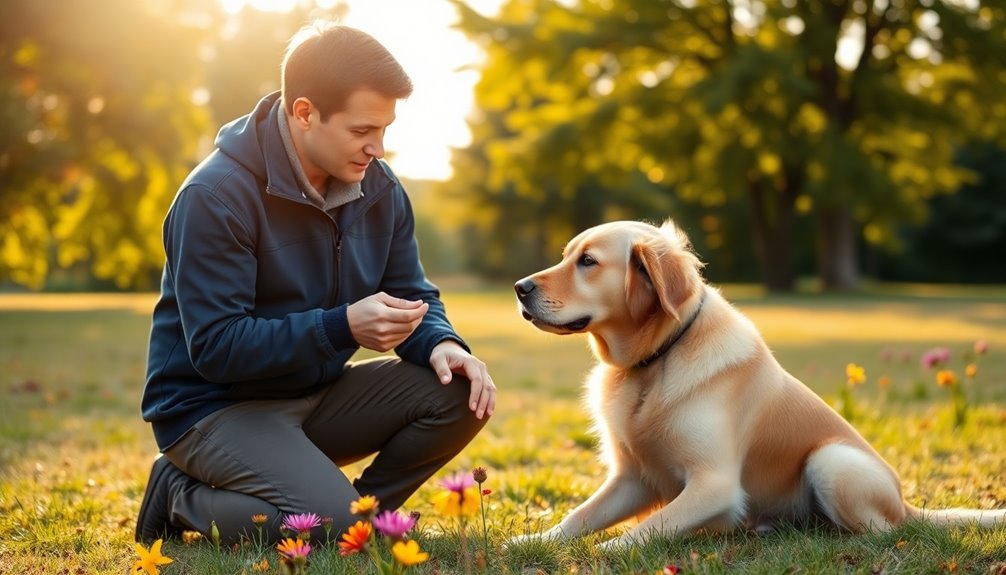
Effective training techniques are essential for addressing aggression in dogs and fostering a harmonious relationship between you and your pet. By implementing positive reinforcement strategies, you can effectively modify aggressive behaviors and encourage calm responses.
Here are some key techniques to evaluate:
- Gradual desensitization: Slowly expose your dog to their unique triggers at a safe distance to help change their emotional responses and reduce aggression.
- Consistency: Establish clear training routines and boundaries. This builds trust and reinforces effective behavior, showing your dog that you're a reliable leader.
- Professional guidance: Working with a certified professional trainer can provide tailored training plans that cater to your dog's specific needs, ensuring successful behavior modification.
Managing Aggression Triggers
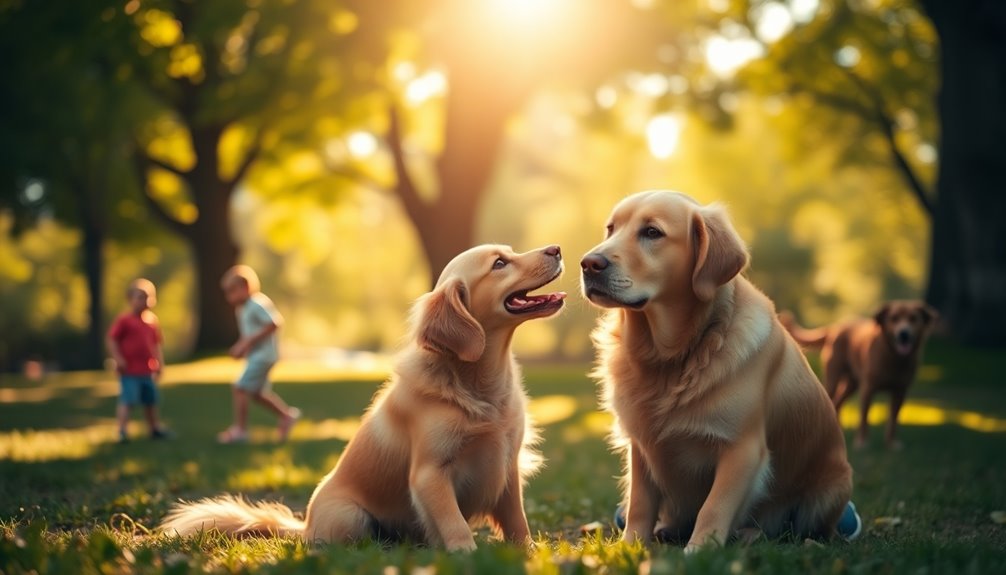
Understanding and managing your dog's aggression triggers is fundamental for promoting a safer environment for both your pet and those around them. Start by identifying specific trigger situations, such as unfamiliar people, other animals, or certain noises. This identification is critical for developing an effective management plan tailored to your dog's needs.
Monitoring your dog's body language during encounters with these triggers can provide valuable insights into their comfort levels. Look for signs of stress or discomfort, as recognizing these early can help prevent aggressive responses.
Gradual desensitization is essential; expose your dog to the triggers at a safe distance while rewarding calm behavior, helping to modify their emotional responses over time.
Implement environmental modifications by creating safe spaces or using physical barriers, which can reduce the likelihood of aggressive incidents. Keeping detailed records of aggressive incidents, including the context and triggers involved, will aid in recognizing patterns and adjusting your management strategies accordingly.
Professional Support Resources
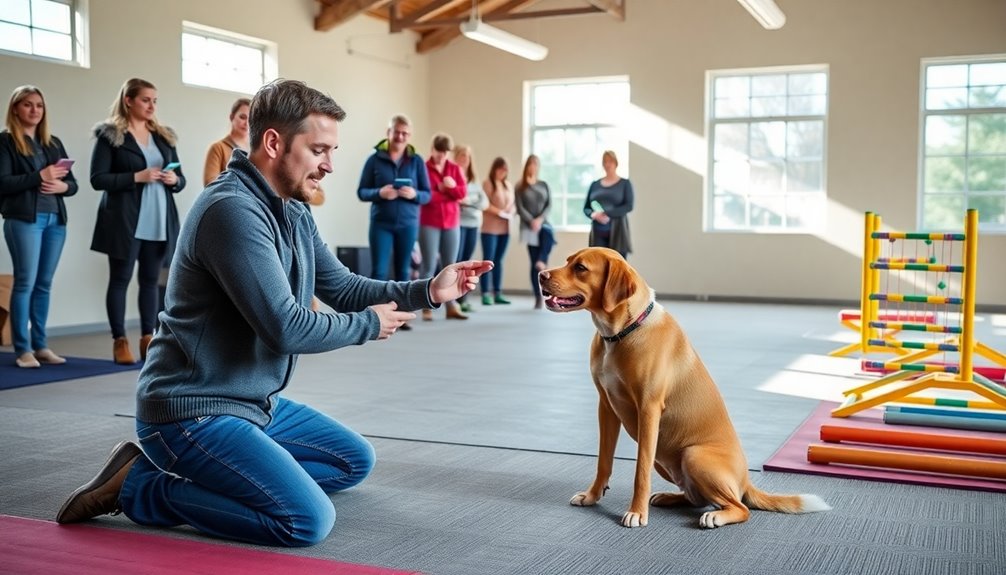
When it comes to managing aggression in dogs, collaborating with certified trainers can make a significant difference.
They'll work with you to create a personalized training plan, while a veterinary behavioral assessment guarantees there aren't any underlying medical issues at play.
Together, these resources provide a solid foundation for addressing your dog's aggression effectively.
Certified Trainer Collaboration
Collaborating with certified trainers or behaviorists is essential for addressing aggression in dogs. These professionals create customized behavior modification plans that cater to your dog's specific aggression triggers and needs. By using positive reinforcement techniques, they help manage aggressive behaviors more effectively than punitive measures, which often worsen anxiety and aggression.
Consider these benefits of working with certified trainers:
- Ongoing assessment of your dog's progress guarantees training strategies are adapted as needed.
- Access to educational resources helps you understand aggressive behaviors, empowering you as a dog owner.
- Trainers' expertise in complex aggression issues leads to effective outcomes for both you and your dog.
Engaging with certified trainers not only enhances your dog's training experience but also provides you with the tools to navigate challenging situations.
Their knowledge and skills are invaluable in helping you manage aggressive behaviors and prevent future incidents. By fostering a collaborative relationship, you can guarantee that your dog receives the best possible support, promoting long-term success and a harmonious life together.
Veterinary Behavioral Assessments
Addressing aggression in dogs often requires a multi-faceted approach, and veterinary behavioral assessments play an important role in this process. These assessments are vital for identifying any underlying medical issues that might contribute to your dog's aggressive behavior, such as hypothyroidism or neurological disorders.
During a veterinary behavioral assessment, a thorough evaluation of your dog's health history, current behavior, and potential environmental triggers will take place. This detailed examination enables a tailored approach to treatment and behavior modification.
Collaboration between your veterinarian and certified animal behaviorists guarantees a holistic understanding of your dog's aggression, helping to create a customized training plan that addresses both medical and behavioral needs. Additionally, ensuring proper socialization opportunities through parks and training classes can greatly aid in reducing aggressive tendencies.
Regular veterinary check-ups are essential for monitoring your dog's health, allowing for adjustments in medications or treatments that may impact behavior.
Living Safely With Aggressive Dogs
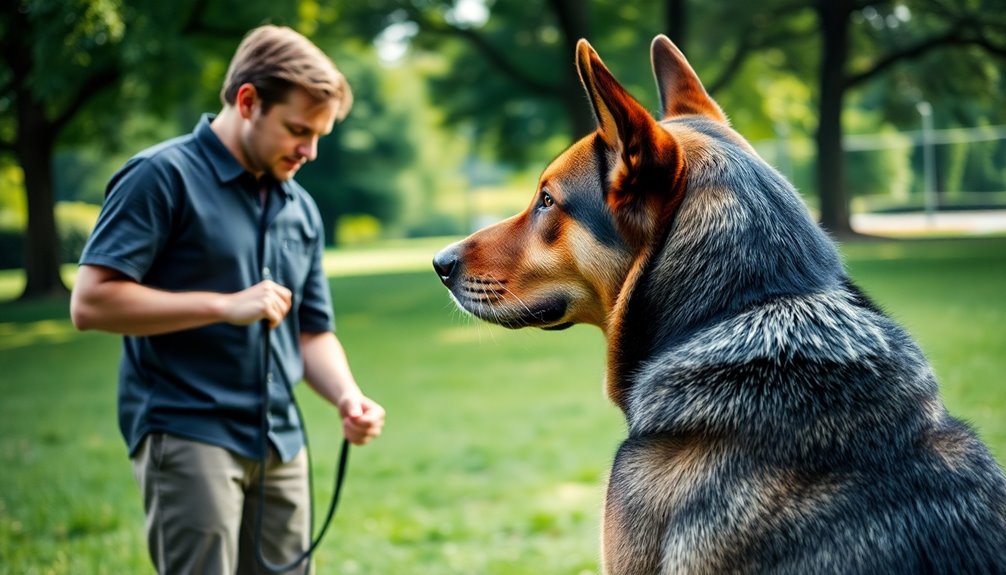
Living with an aggressive dog can be challenging, but with the right strategies, you can create a safe environment for both your pet and those around you. Close supervision is essential to prevent aggression and guarantee safety. By identifying triggers and monitoring your dog's behavior, you can adapt management strategies effectively.
Here are some practical steps to take into account:
- Create a safe space: Use gates or crates to give your dog a retreat when feeling overwhelmed.
- Muzzle training: This allows for controlled outings, minimizing the risk of biting while helping your dog overcome behavioral problems.
- Implement management strategies: Use leashes or head halters during walks to maintain control and prevent aggressive lunging.
Always be aware of your dog's triggers and adjust your approach as needed. If you're struggling, a professional can help you develop a tailored plan to manage aggression.
Frequently Asked Questions
What Is the Best Way to Stop an Aggressive Dog?
To stop an aggressive dog, you should focus on positive reinforcement training. Reward calm behavior and encourage desirable actions instead of using punishment, which can worsen aggression.
Gradually desensitize your dog to triggers by introducing them at a safe distance while rewarding calmness. Identifying and managing environmental triggers is essential too.
Finally, consider consulting a certified trainer for tailored strategies, and make certain to have regular vet check-ups to rule out any medical issues.
Can Aggression Be Trained Out of a Dog?
Can aggression really be trained out of a dog? You might be surprised to learn that it often can.
With consistent training and positive reinforcement, you can help your dog respond differently to triggers. It's essential to work with a certified trainer who can tailor a plan to your dog's specific needs.
Patience and ongoing evaluation of the strategies are key. Over time, you'll see improvements in your dog's behavior and overall happiness.
How to Get Aggression Out of a Dog?
To get aggression out of your dog, start by identifying the root cause, like fear or anxiety.
Consult a vet to rule out any medical issues.
Use positive reinforcement to reward calm behavior, gradually exposing your dog to triggers in a controlled manner.
Establish consistent boundaries at home to build trust.
Document incidents to spot patterns and provide a safe space for your dog to retreat when feeling overwhelmed.
What Calms Aggression in Dogs?
If you want to turn your dog from a raging bull into a calm companion, start by creating a consistent routine and providing a stable environment.
Regular exercise and mental stimulation will help burn off excess energy that can fuel aggression.
Use positive reinforcement to reward calm behavior, and set up safe spaces where your dog can retreat when overwhelmed.
Consider calming aids like pheromone diffusers to further soothe your furry friend.
Conclusion
In your journey towards a harmonious relationship with your dog, remember that understanding and patience are your best allies. By recognizing the nuances of aggression and applying effective training techniques, you can transform challenging behaviors into positive experiences. Embrace the support of professionals when needed, and always prioritize safety for both you and your furry friend. With dedication and love, you'll uncover the delightful companionship that lies beneath the surface, turning obstacles into opportunities for growth.

